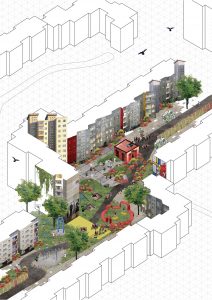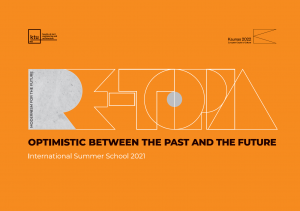Students from Europe analyzed and suggested visions for the renovation of a Soviet-era apartments territory.
During the International summer school “RE-TOPIA: optimistic between the past and the future” students from Lithuania, Macedonia, Spain, Estonia, the Netherlands and Ukraine developed visions on how to improve Soviet-era residential areas to make them more modern and more attractive. The Summer school was organized by the Faculty of Civil Engineering and Architecture of Kaunas University of Technology and presented by Kaunas – European Capital of Culture 2022. All the ideas of the participants were published in a special publication.
According to the organizers, the aim of the International Summer School was to stimulate discussions among students, young professionals and residents about the residential architecture of Soviet modernism. The school took place in two stages in 2021 June – a seminar with guest lecturers and a week-long creative workshop.
Problems of the territory – spatial planning, population health and ecology
“The fate of Soviet-era apartment buildings and neighborhoods is relevant and interesting not only in the Lithuanian context, but also internationally, because this type or similar buildings and districts from the 20th century there are more than in one European country. This is especially important because most of these buildings are approaching to the age, according to V. Šlapeta a professor from the Czech Republic who gave a lecture during the seminar, when we have to think – what to do with them: renovate or demolish or maybe protect them? Multi-apartment areas face ownership, function, and maintenance challenges. We often see how various small shops/buisnesses are located on the first floors of apartment buildings, thus changing not only the architectural expression of the building, but also the urban structure of the blocks. Areas around apartment buildings, courtyards, public spaces lose their function, attractiveness, meet, often, only the need for parking. Such multi-apartment public spaces form a sense of exclusion rather than communication and cooperation, ”assures the project coordinator Laura Jankauskaitė-Jurevičienė.
According to her, what was attractive, functional and modern in the 20ths century does not fully meet the needs and expectations of 21st-century society.
Project participants were introduced to three main topics that are relevant to Soviet-era apartment districts: the issue of space – how to redesign and redistribute space inside (buildings) and outside (courtyards) to meet today’s society needs; the relationship between the building and its environment, and the issue of urban resilience – the health and well-being of the population and the urban ecology.
As the Summer school was held remotely, in order to understand the context of the research territory, the participants were introduced by recorded virtual interviews: the architectural historian Doc. dr. Vaidas Petrulis presented the short history of the territory, architect Vidmantas Minkevičius raised the current issues with the renovation of the buildings and district, and the residents of Eiguliai were interviewed simply on the street or in the yard by asking to name the problems from their point of view. As architect Vidmantas Minkevičius mentioned, when examining such districts, it is necessary to look more broadly at the problems: “We are tackling the challenges of the whole district and what it will look like from a city perspective”
Solutions- less cars and fences in the district
 There was certainly no shortage of ideas for the participants, but the project coordinator reminds us that they should be seen first and foremost as a kind of speculation, a matter for discussion and a new utopian vision, but not as a real project.
There was certainly no shortage of ideas for the participants, but the project coordinator reminds us that they should be seen first and foremost as a kind of speculation, a matter for discussion and a new utopian vision, but not as a real project.
“Even several teams have heard the residents’ needs for green space, rest and peace, so the vision proposed by one of them is called “Symbiosis ” – A kind of dialogue between people living in the same neighbourhood and the space where they gather. They are proposing to create a mixed-use public space and revitalize the busy inner streets or yards of Eiguliai, where different age groups gather and spend time together. The closed for cars streets become freely accessible to all and becomes the property of the residents. Such spatial equality would act as an adhesive that connects people, brings them together, invites them to talk and organize. Art on the walls of buildings and playgrounds would act as accents of colour, ”L. Jankauskaitė-Jurevičienė presented the students’ idea, adding that this team also offered to turn part of the district into a real forest that would surround apartment buildings.
The utopian vision proposed by another team tried to address the issue of building renovation and the associated discomfort experienced by residents. Their idea was to create a structure above the existing buildings – balconies, an extra room or even an entire floor during the renovation. In order not only to improve the quality of life and meet the needs of the population but also to create additional living space from the “superstructures” – futuristic urban compaction, preserving the space around the buildings.
More green space will create the resilient community
Summarizing all visions of the participants, it is noticeable that they declared the need for green, public spaces, the opportunity to create a sense of community, communication and coexistence, thus reducing social exclusion and alienation.
According to the project coordinator, such ideas and the thoughts of students heard during the project from different cultures and places of residence encourage us to rethink the ideas where we should go with urban planning, what is most important for 21st-century society.
“When interacting with students, we had to re-evaluate what we know as professionals and what local people or observers/participants from another country see. Different experiences and contexts create different visions. It seems to me that the value of the project lies in the diversity, the lectures, the way of thinking, the clash of cultures and the ideas arising from it, ”said L. Jankauskaitė-Jurevičienė.
The project publication (in English) is available here – https://fcea.ktu.edu/summerschool/
The project will continue next year. Only this time it is expected that the participants will be able to come to Kaunas to work and to think in the real context about the Relationship between Nature and Modernity.


